Effects of Typhoon Chanthu on Marine Chlorophyll a, Temperature and Salinity
Abstract
:1. Introduction
2. Materials and Methods
2.1. Wind
2.2. Temperature and Salinity
2.3. Chl a Concentration
2.4. Ekman Pumping Velocity (EPV)
3. Results
3.1. Variations in the Sea Surface Wind Field
3.2. Distribution of SST
3.3. Distribution of SSS
3.4. Distribution of Sea Surface Chl a
4. Discussion
4.1. Effect of Typhoon on EPV
4.2. Effect of Typhoon on Temperature
4.3. Effect of Typhoon on Salinity
4.4. Effect of Typhoon on Chl a Concentration
5. Conclusions
- (1)
- The transit of Chanthu reduced the SST by an average of 1.58 °C, and the cooling process lasted more than two weeks. The SST on the right side of the typhoon track decreased significantly, and the cooling was right-skewed. The SST rebounded two weeks after the typhoon, but it was still lower than before. The SST drop was mainly affected by the deep cold water upwelling and seawater mixing caused by the typhoon;
- (2)
- The SSS of the sea area affected by Canhtu increased by an average of 0.28 psu. The SSS growth continued for six days and reached its highest on the third day. The SSS decreased one week after transit and decreased to the lowest on the 10th day. The whole decline process lasted for two weeks. The SSS rising area was mainly concentrated in the coastal waters of the Yangtze River estuary, and the falling area was mainly distributed in the south of Hangzhou Bay. The increased SSS was mainly affected by the upwelling of deep, high salt water. The decreased SSS was mainly affected by the weakening and disappearance of upwelling caused by the departure of the typhoon and the rainfall caused by the typhoon;
- (3)
- The influence of Chanthu increased the concentration of Chl a in the study area to 0.74 times higher than before. The whole growth process lasted for two weeks, and the maximum value appeared on the fifth day after the typhoon. The response of Chl a to the typhoon had a certain delay, and the increased area was mainly concentrated near the typhoon path and offshore waters. The increase of Chl a concentration was mainly affected by the strengthening of marine dynamic mechanisms, such as seawater mixing and upwelling caused by the typhoon and the influence of continental runoff.
Author Contributions
Funding
Institutional Review Board Statement
Informed Consent Statement
Data Availability Statement
Conflicts of Interest
References
- Falkowski, P.G. The role of phytoplankton photosynthesis in global biogeochemical cycles. Photosynth Res. 1994, 39, 235–258. [Google Scholar] [CrossRef] [PubMed]
- Zhao, H.; Wang, Y. Phytoplankton Increases Induced by Tropical Cyclones in the South China Sea During 1998–2015. J. Geophys. Res. Ocean. 2018, 123, 2903–2920. [Google Scholar] [CrossRef]
- Hallegraeff, G.M. A review of harmful algal blooms and their apparent global increase. Phycologia 1993, 32, 79–99. [Google Scholar] [CrossRef]
- Price, J.F. Upper ocean response to a hurricane. J. Phys. Oceanogr. 1981, 11, 153–175. [Google Scholar] [CrossRef]
- Font, J.; Kerr, Y.H.; Srokosz, M.A.; Etcheto, J.; Lagerloef, G.S.; Camps, A.; Waldteufel, P. SMOS: A Satellite Mission to Measure Ocean Surface Salinity. Conf. Atmos. Propag. Adapt. Syst. Laser Radar Technol. Remote Sens. 2001, 4167, 207–214. [Google Scholar]
- Yin, X.B. A Study on the Passive Microwave Remote Sensing of Sea Surface Wind Vector, Temperature and Salinity and the Effect of Wind on Remote Sensing of Temperature and Salinity; Ocean University of China: Qingdao, China, 2007. [Google Scholar]
- Cao, K.X.; Jin, X.F.; Sun, W.F.; Wang, J. Quality assessment and correction of SST fusion product in the Bohai Sea and the Huanghai Seas. Mar. Sci. 2017, 41, 50–55. [Google Scholar]
- Mecklenburg, S.; Drusch, M.; Kerr, Y.H.; Font, J.; Martin-Neira, M.; Delwart, S.; Buenadicha, G.; Reul, N.; Daganzo-Eusebio, E.; Oliva, R.; et al. ESA’s Soil Moisture and Ocean Salinity Mission: Mission Performance and Operations. IEEE Trans. Geosci. Remote Sens. 2012, 50, 1354–1366. [Google Scholar] [CrossRef]
- Stramma, L.; Cornillon, P.; Price, J.F. Satellite observations of sea surface cooling by hurricanes. J. Geophys. Res. Ocean. 1986, 91, 5031–5035. [Google Scholar] [CrossRef]
- Zhao, H.; Tang, D.L.; Wang, Y. Comparison of phytoplankton blooms triggered by two typhoons with different intensities and translation speeds in the South China Sea. Mar. Ecol. Prog. Ser. 2008, 365, 57–65. [Google Scholar] [CrossRef]
- Shi, W.; Wang, M. Observations of a hurricane katrina-induced phytoplankton bloom in the gulf of Mexico. Geophys. Res. Lett. 2007, 34, 607–612. [Google Scholar] [CrossRef]
- Lin, I.I.; Liu, W.T.; Wu, C.C.; Chiang, J.C.; Sui, C.H. satellite observations of modulation of surface winds by typhoon-induced upper ocean cooling. Geophys. Res. Lett. 2003, 30, 1-131–1-135. [Google Scholar] [CrossRef]
- Lin, I.; Liu, W.T.; Wu, C.C.; Wong, G.T.; Hu, C.; Chen, Z.; Liang, W.D.; Yang, Y.; Liu, K.K. New evidence for enhanced ocean primary production triggered by tropical cyclone. Geophys. Res. Lett. 2003, 30, 1718–1722. [Google Scholar] [CrossRef]
- Walker, N.D.; Leben, R.R.; Balasubramanian, S. Hurricane-forced upwelling and chlorophyll a enhancement within cold-core cyclones in the Gulf of Mexico. Geophys. Res. Lett. 2005, 32, L18610. [Google Scholar] [CrossRef]
- Narvekar, J.; Roy Chowdhury, R.; Gaonkar, D.; Kumar, P.D.; Prasanna Kumar, S. Observational evidence of stratification control of upwelling and pelagic fishery in the eastern Arabian Sea. Sci. Rep. 2021, 11, 7293. [Google Scholar] [CrossRef] [PubMed]
- Yin, X.; Wang, Z.; Liu, Y.; Xu, Y. Ocean response to Typhoon Ketsana traveling over the northwest Pacific and a numerical model approach. Geophys. Res. Lett. 2007, 34, L21606-1–L21606-6. [Google Scholar] [CrossRef]
- Cao, K.X.; Sun, W.F.; Meng, J.M.; Zhang, J. Assessment and Comparison of Sea Surface Salinity Data Derived From SMAP and SMOS Based on Argo M easurements. Adv. Mar. Sci. 2019, 37, 574–587. [Google Scholar]
- Bhaskar, T.V.S.U.; Jayaram, C. Evaluation of Aquarius Sea Surface Salinity with Argo Sea Surface Salinity in the Tropical Indian Ocean. Geosci. Remote Sens. Lett. IEEE 2015, 12, 1292–1296. [Google Scholar] [CrossRef]
- Tang, W.; Yueh, S.H.; Fore, A.G.; Hayashi, A. Validation of Aquarius sea surface salinity with in situ measurements from Argo floats and moored buoys. J. Geophys. Res. Ocean. 2014, 119, 6171–6189. [Google Scholar] [CrossRef]
- Le Vine, D.M.; Lagerloef, G.S.E.; Torrusio, S.E. Aquarius and Remote Sensing of Sea Surface Salinity from Space. Proc. IEEE 2010, 98, 688–703. [Google Scholar] [CrossRef]
- Just! Typhoon Chando, the 14th Typhoon of This Year, Formed in the Northwest Pacific Ocean. China Weather Network, 2021. Available online: http://news.weather.com.cn/2021/09/3491355.shtml (accessed on 21 July 2023).
- Typhoon ‘Chandu’ Was Generated and Is Expected to Affect the Offshore Fishing Grounds in Fujian after 11 Days. Guangzhou Daily. 2021. Available online: https://www.gzdaily.cn/amucsite/web/index.html#/detail/1653936 (accessed on 21 July 2023).
- Typhoon Chanthu No. 14 Strengthened into a Super Typhoon, and will Be Seen Tomorrow or Near the Coast of Guangdong and Fujian. Guangzhou Daily. 2021. Available online: https://baijiahao.baidu.com/s?id=1710293479196671127&wfr=spider&for=pc (accessed on 21 July 2023).
- This year’s No.14 Typhoon Canyon landed in Fukuoka County, Japan Only. CCTV News. 2021. Available online: http://m.news.cctv.com/2021/09/17/ARTIrjf44FLbHGzDC7al7EIJ210917.shtml (accessed on 21 July 2023).
- Monod, J. Recherches sur la Croissance des Cultures Bactériennes; Hermann: Paris, France, 1942; p. 1377. [Google Scholar]
- Geider, R.J.; Macintyre, H.L.; Kana, T.M. A dynamic model of photoadaptation in phytoplankton. Limnol. Oceanogr. 1996, 41, 1–15. [Google Scholar] [CrossRef]
- Geider, R.J.; Macintyre, H.L.; Kana, T.M. Dynamic model of phytoplankton growth and acclimation: Responses of the balanced growth rate and the chlorophyll a:carbon ratio to light, nutrient-limitation and temperature. Mar. Ecol. Prog. 1997, 148, 187–200. [Google Scholar] [CrossRef]
- Ch, V.; Deo, A.A. Study of upper ocean parameters during passage of tropical cyclones over Indian seas. Int. J. Remote Sens. 2019, 40, 4683–4723. [Google Scholar] [CrossRef]
- Taylor, G.I. Skin Friction of the Wind on the Earth’s Surface. Proceedings of the Royal Society of London. Ser. A Contain. Pap. A Math. Phys. Character 1916, 92, 196–199. [Google Scholar]
- Hu, M.G.; Zhao, C.F. Upwelling in Zhejang Coastal Areas during Suummer Detected by Satellite observations. Natl. Remote Sens. Bull. 2008, 12, 297–304. [Google Scholar]
- Liu, Z.H.; Xu, J.P.; Zhu, B.K.; Sun, Z.; Zhang, L. Upper ocean response to tropical cyclones in northwestern Pacific during 2001–2004 by Argo data. J. Trop. Ocean. 2006, 25, 1–8. [Google Scholar]
- Chang, Y.; Liao, H.-T.; Lee, M.-A.; Chan, J.-W.; Shieh, W.-J.; Lee, K.-T.; Wang, G.-H.; Lan, Y.-C. Multisatellite observation on upwelling after the passage of Typhoon Hai-Tang in the southern East China Sea. Geophys. Res. Lett. 2008, 35, 3612-1–3612-5. [Google Scholar] [CrossRef]
- Beardsley, R.; Limeburner, R.; Yu, H.; Cannon, G. Discharge of the Changjiang (Yangtze River) into the East China Sea. Cont. Shelf Res. 1985, 4, 57–76. [Google Scholar] [CrossRef]
- Lin, I.-I.; Wu, C.-C.; Pun, I.-F.; Ko, D.-S. Upper-ocean thermal structure and the western North Pacific category 5 typhoons. Part I: Ocean features and the category 5 typhoons’ intensification. Mon. Weather Rev. 2008, 136, 3288–3306. [Google Scholar] [CrossRef]
- Shang, S.; Li, L.; Sun, F.; Wu, J.; Hu, C.; Chen, D.; Ning, X.; Qiu, Y.; Zhang, C.; Shang, S. Changes of temperature and bio-optical properties in the South China Sea in response to Typhoon Lingling, 2001. Geophys. Res. Lett. 2008, 35, L10602-1–L10602-6. [Google Scholar] [CrossRef]
- McKinnon, A.D.; Meekan, M.G.; Carleton, J.H.; Furnas, M.; Duggan, S.; Skirving, W. Rapid changes in shelf waters and pelagic communities on the southern Northwest Shelf, Australia, following a tropical cyclone. Cont. Shelf Res. 2003, 23, 93–111. [Google Scholar] [CrossRef]
- Shiah, F.-K.; Chung, S.-W.; Kao, S.-J.; Gong, G.-C.; Liu, K.-K. Biological and hydrographical responses to tropical cyclones(typhoons) in the continental shelf of the Taiwan Strait. Cont. Shelf Res. 2000, 20, 2029–2044. [Google Scholar] [CrossRef]
- Zhao, H.; Tang, D.L.; Wang, D.X. Phytoplankton blooms near the Pearl River estuary induced by Typhoon Nuri. J. Geophys. Res. Ocean. 2009, 114, 1–9. [Google Scholar] [CrossRef]
- Fu, D.Y.; Pan, D.L.; Ding, Y.Z.; Zou, J.H. Quantitative study of effects of the sea chlorophyl-a concent ration by typhoon based on remote sensing. Haiyang Xuebao 2009, 31, 46–56. [Google Scholar]
- Fu, D.Y.; Ding, Y.Z.; Liu, D.Z.; Pan, D.L. Remote- Sensing Study of the Effect of Typhoon on Chlorophyll-a Concentration in the Southeast China Sea. J. Guangdong Ocean Univ. 2008, 28, 73–76. [Google Scholar]
 represents the tropical depression,
represents the tropical depression,  represents the tropical storm,
represents the tropical storm,  represents the strong tropical storm,
represents the strong tropical storm,  represents the typhoon,
represents the typhoon,  represents the strong typhoon,
represents the strong typhoon,  represents the super typhoon, and the circular size represents the typhoon intensity.
represents the super typhoon, and the circular size represents the typhoon intensity.
 represents the tropical depression,
represents the tropical depression,  represents the tropical storm,
represents the tropical storm,  represents the strong tropical storm,
represents the strong tropical storm,  represents the typhoon,
represents the typhoon,  represents the strong typhoon,
represents the strong typhoon,  represents the super typhoon, and the circular size represents the typhoon intensity.
represents the super typhoon, and the circular size represents the typhoon intensity.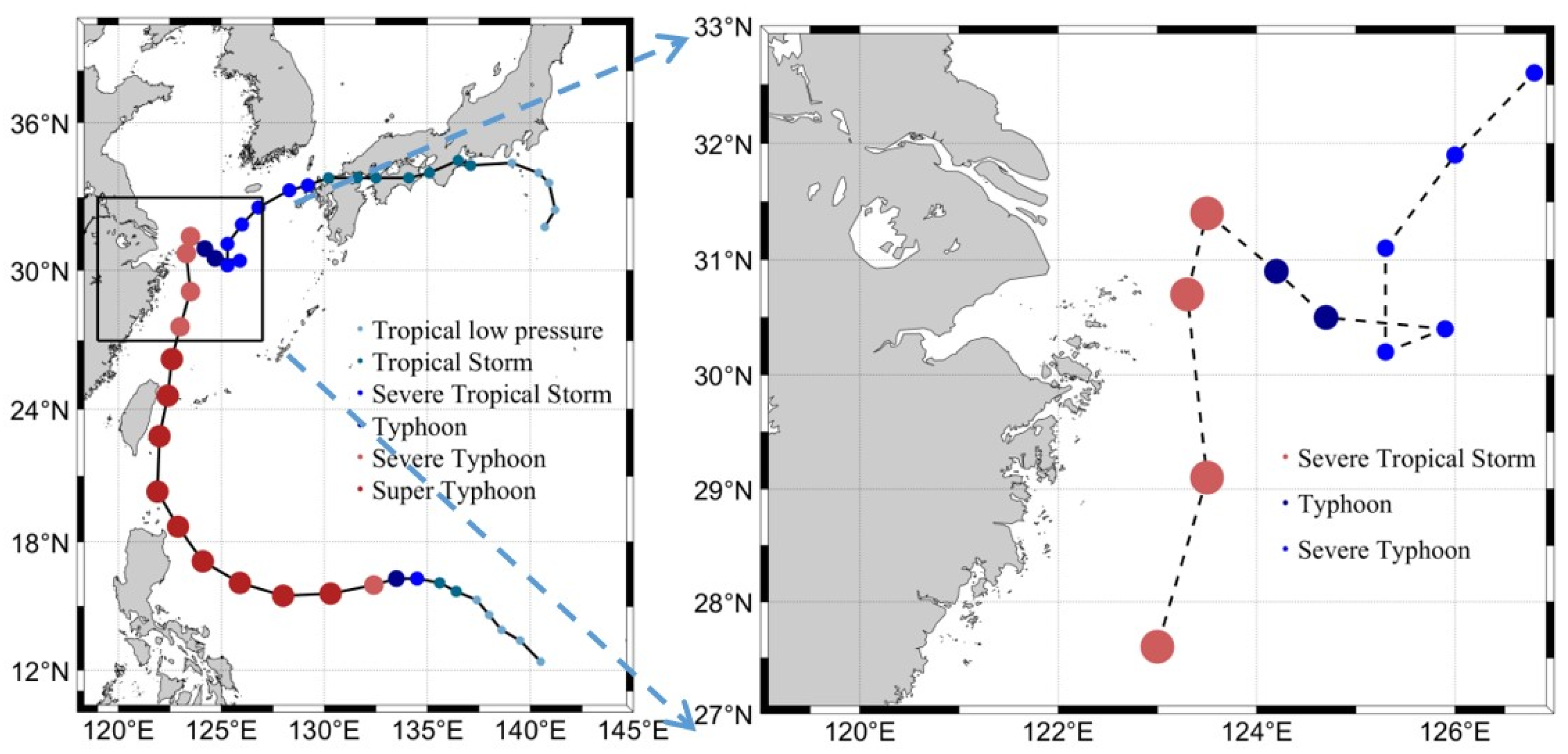
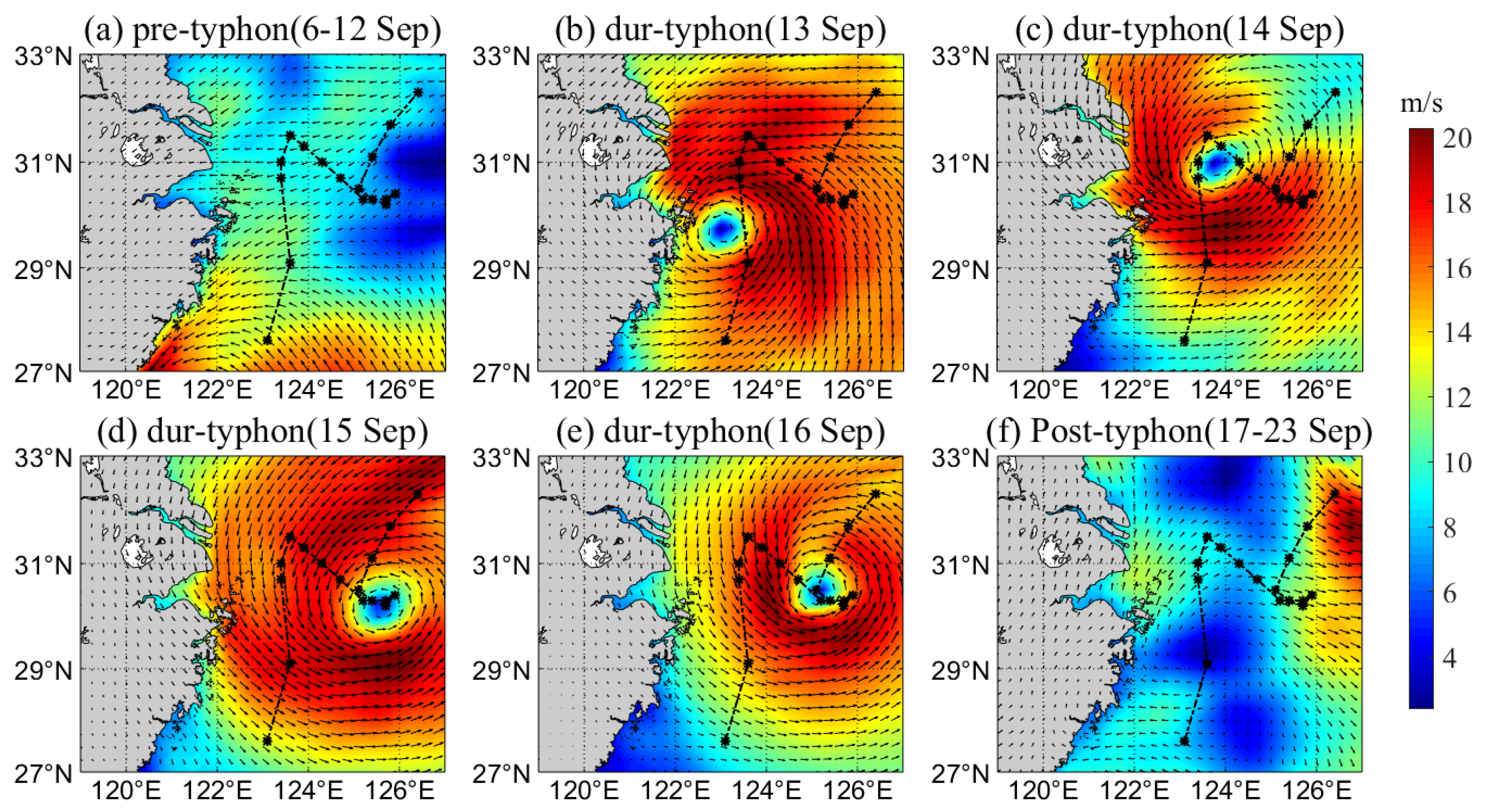

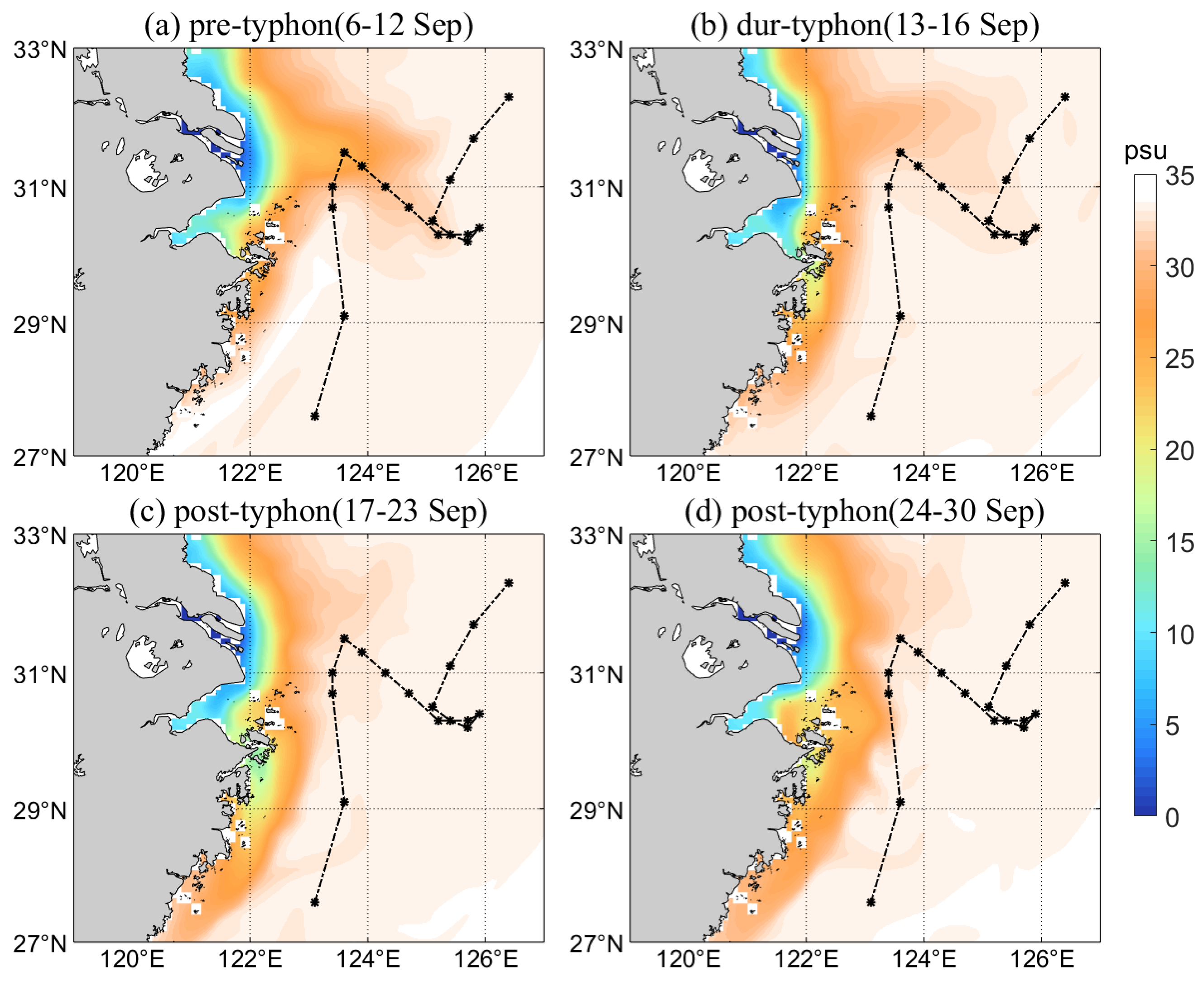
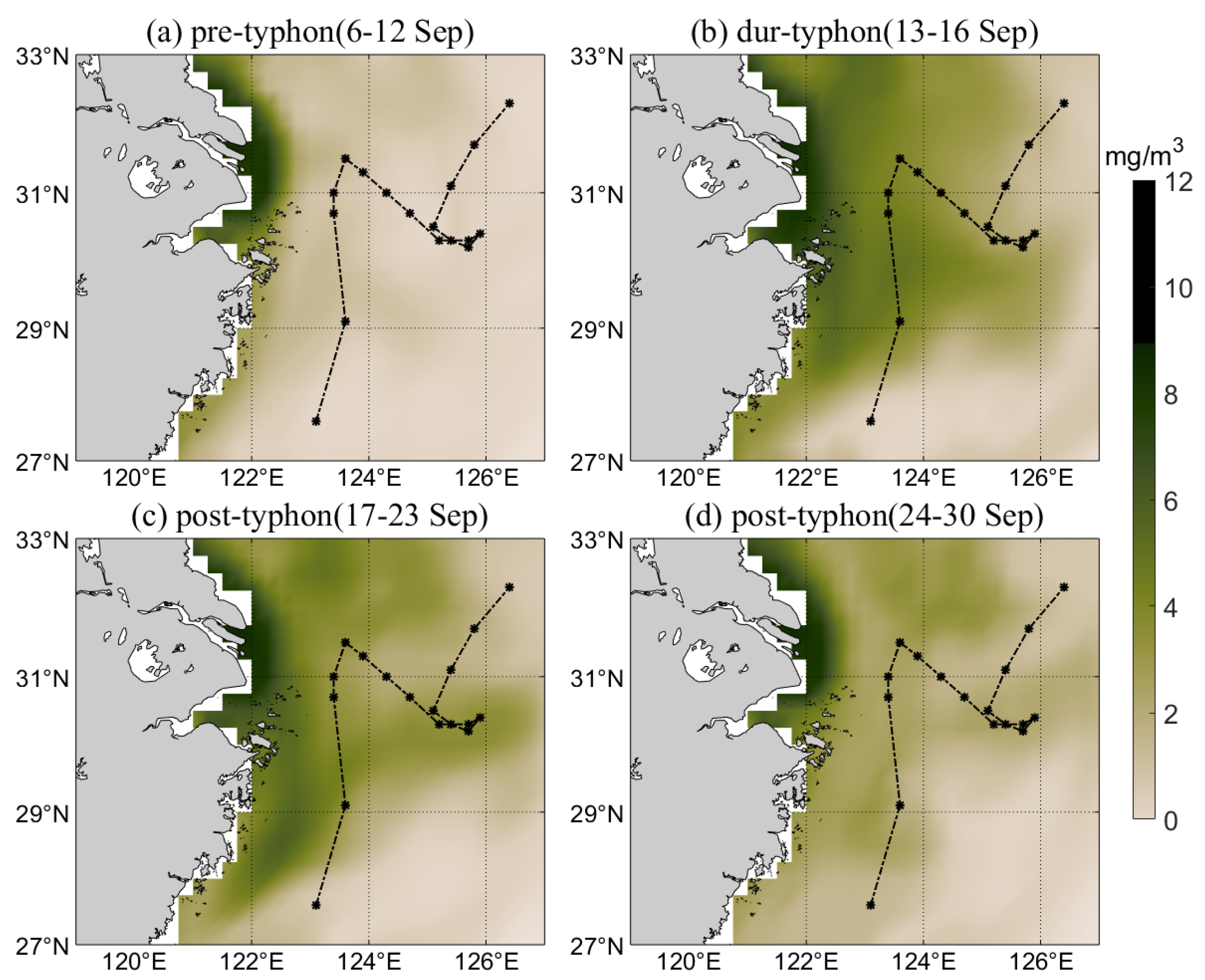

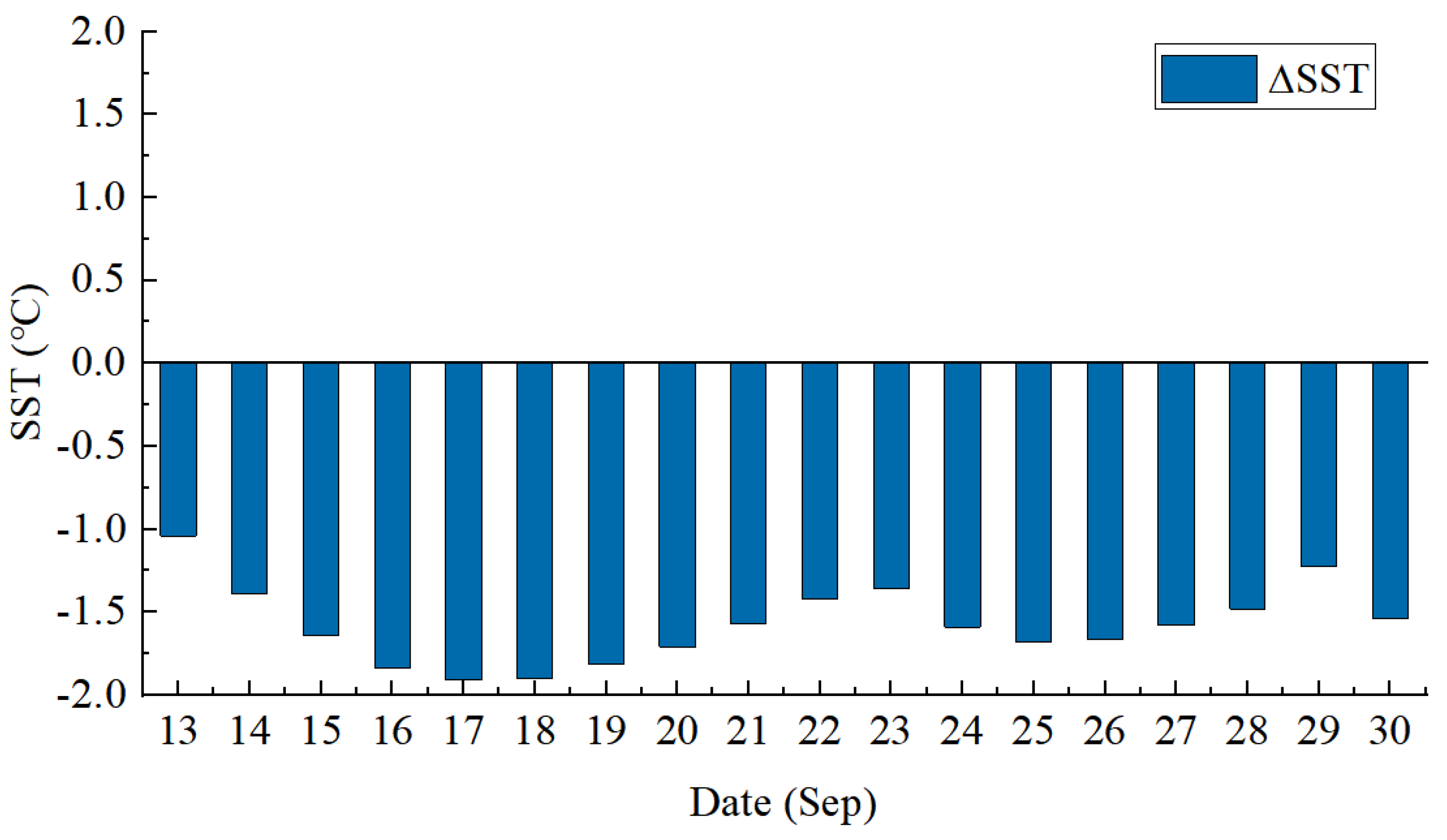

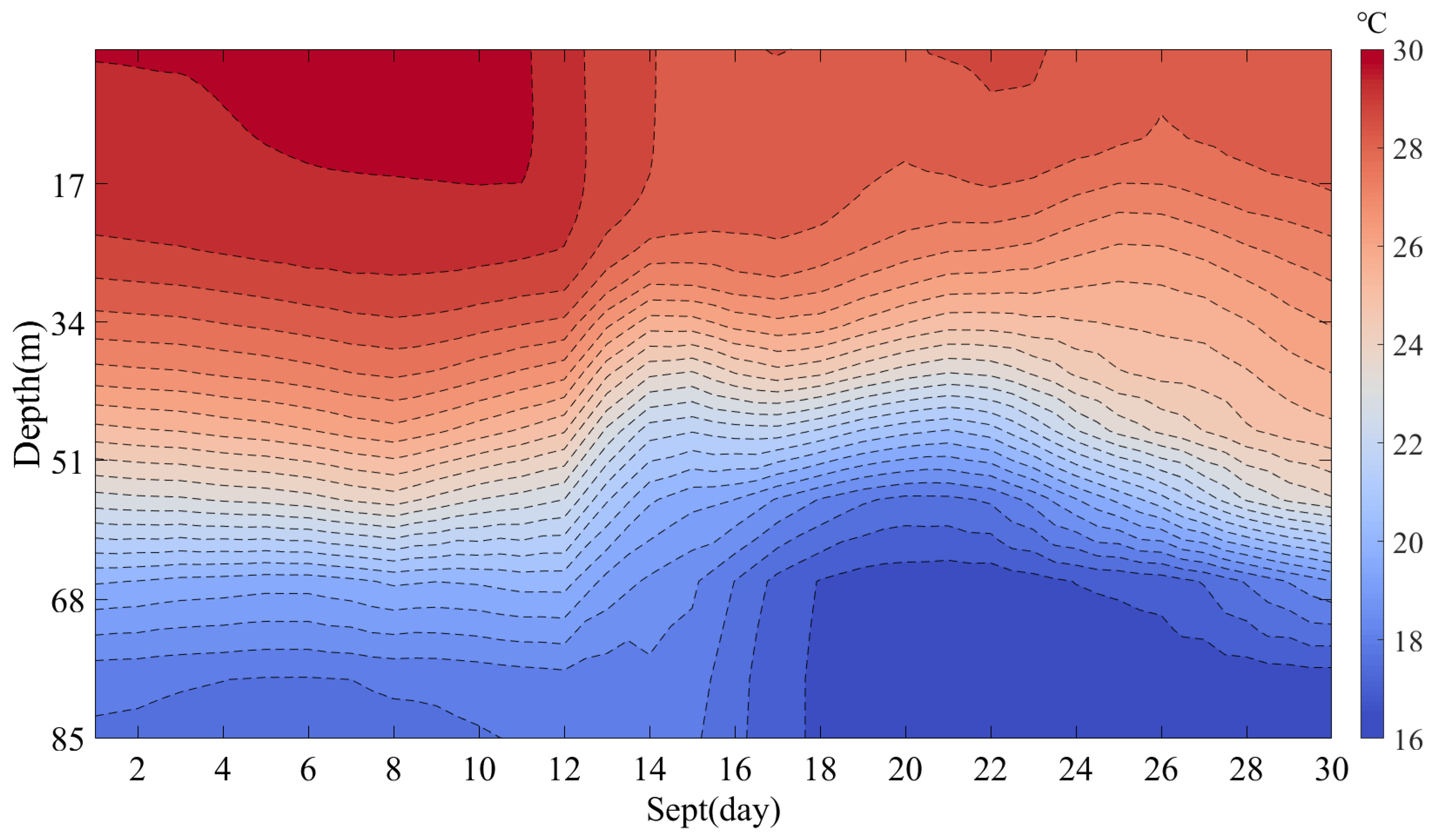

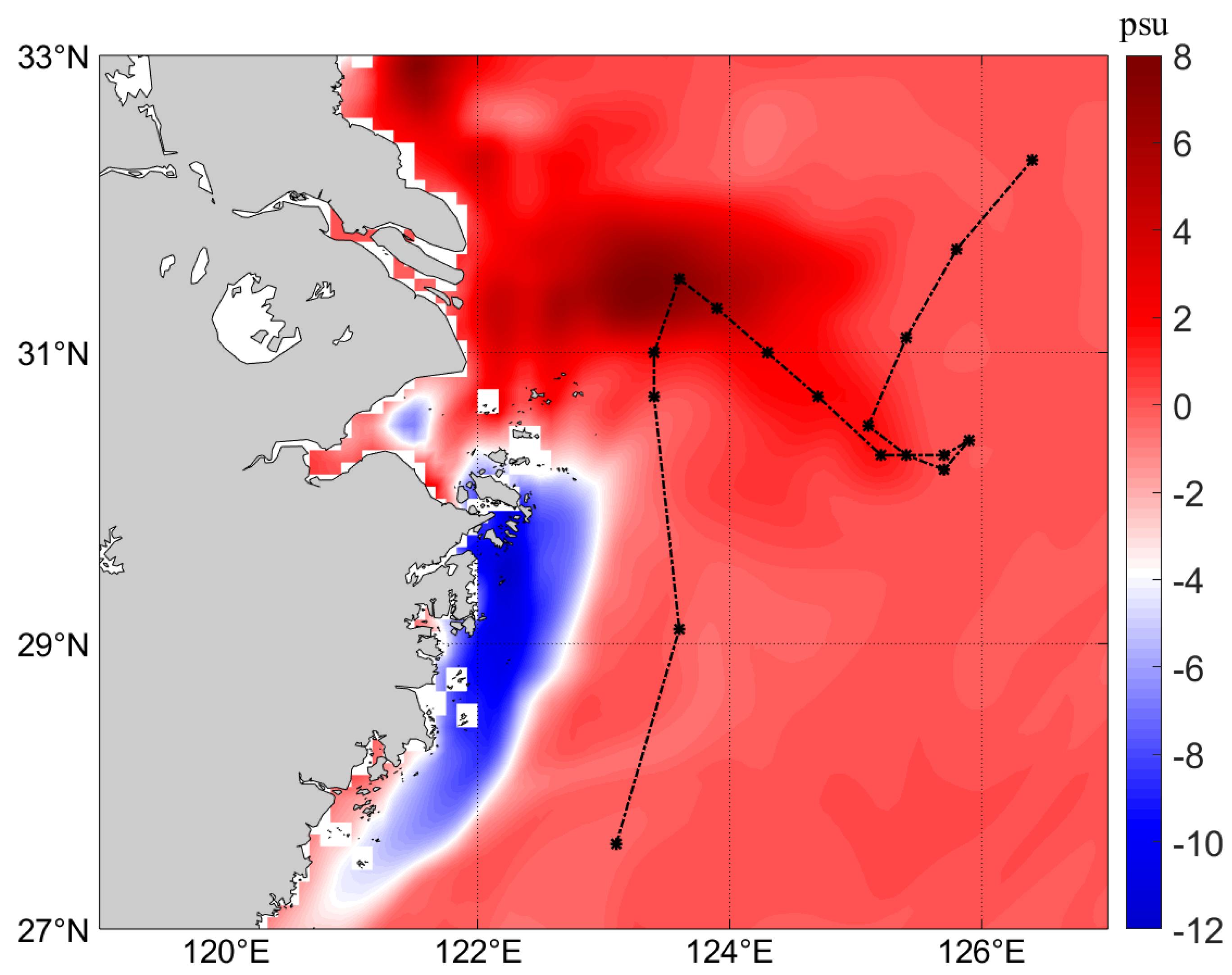
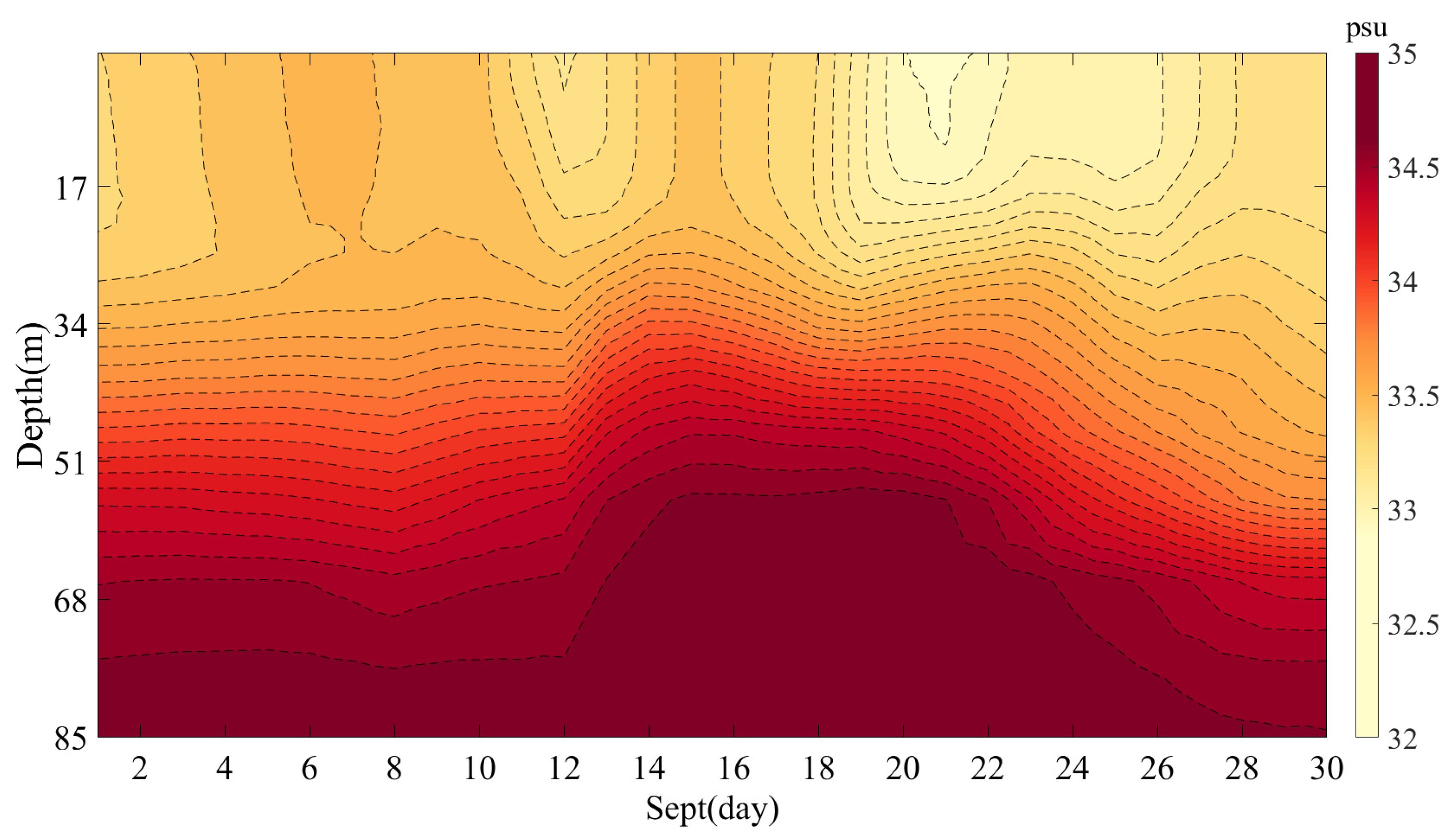
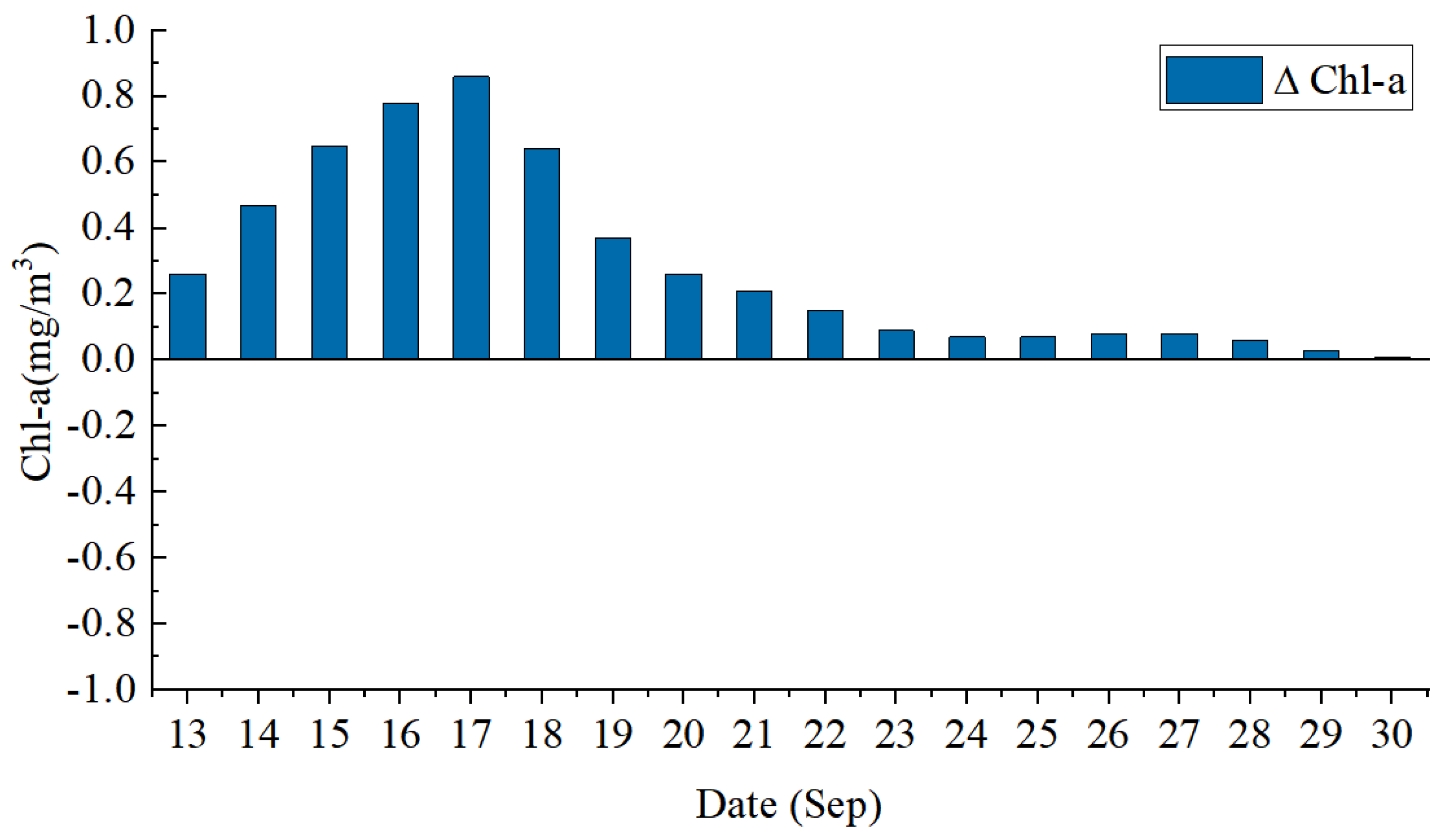

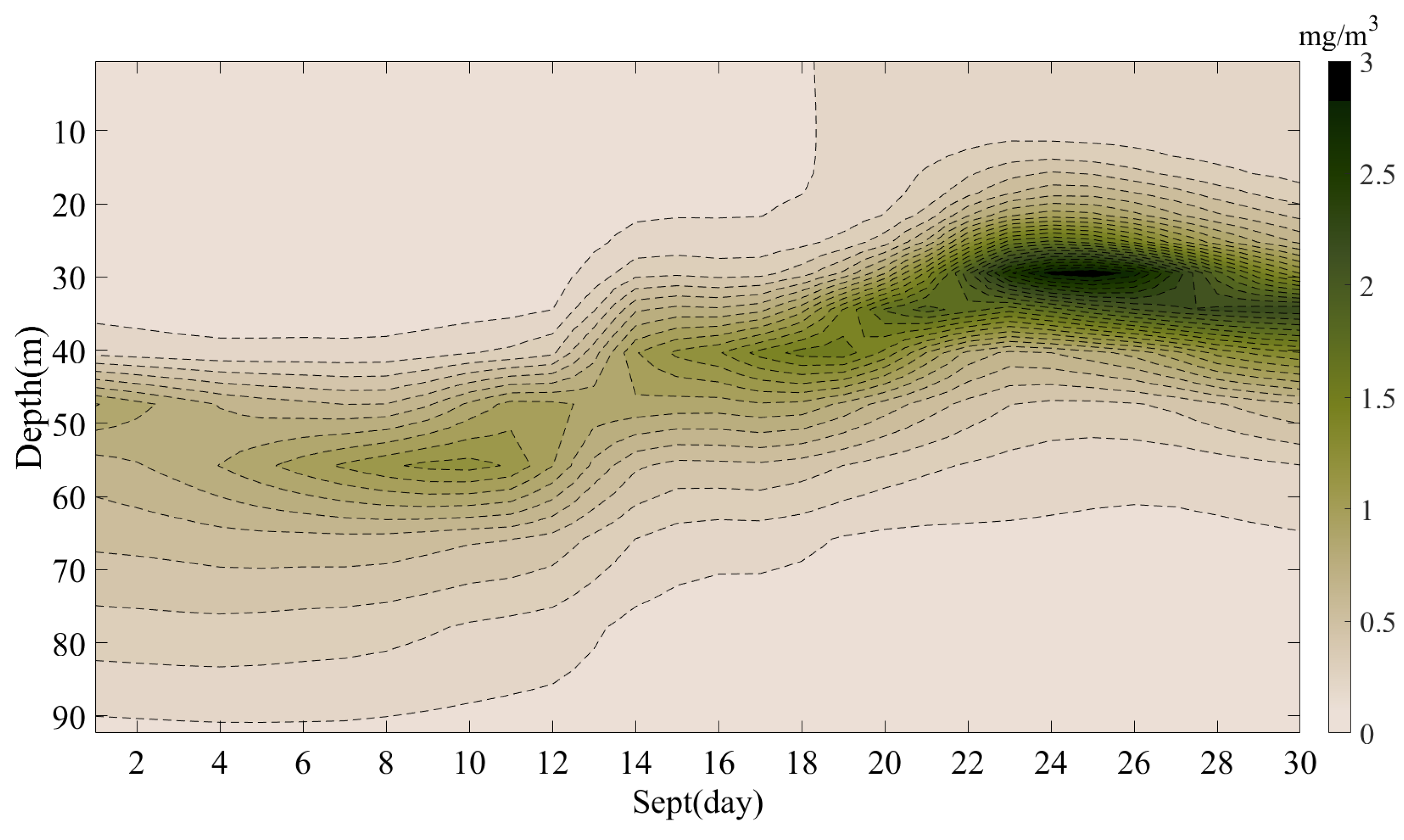
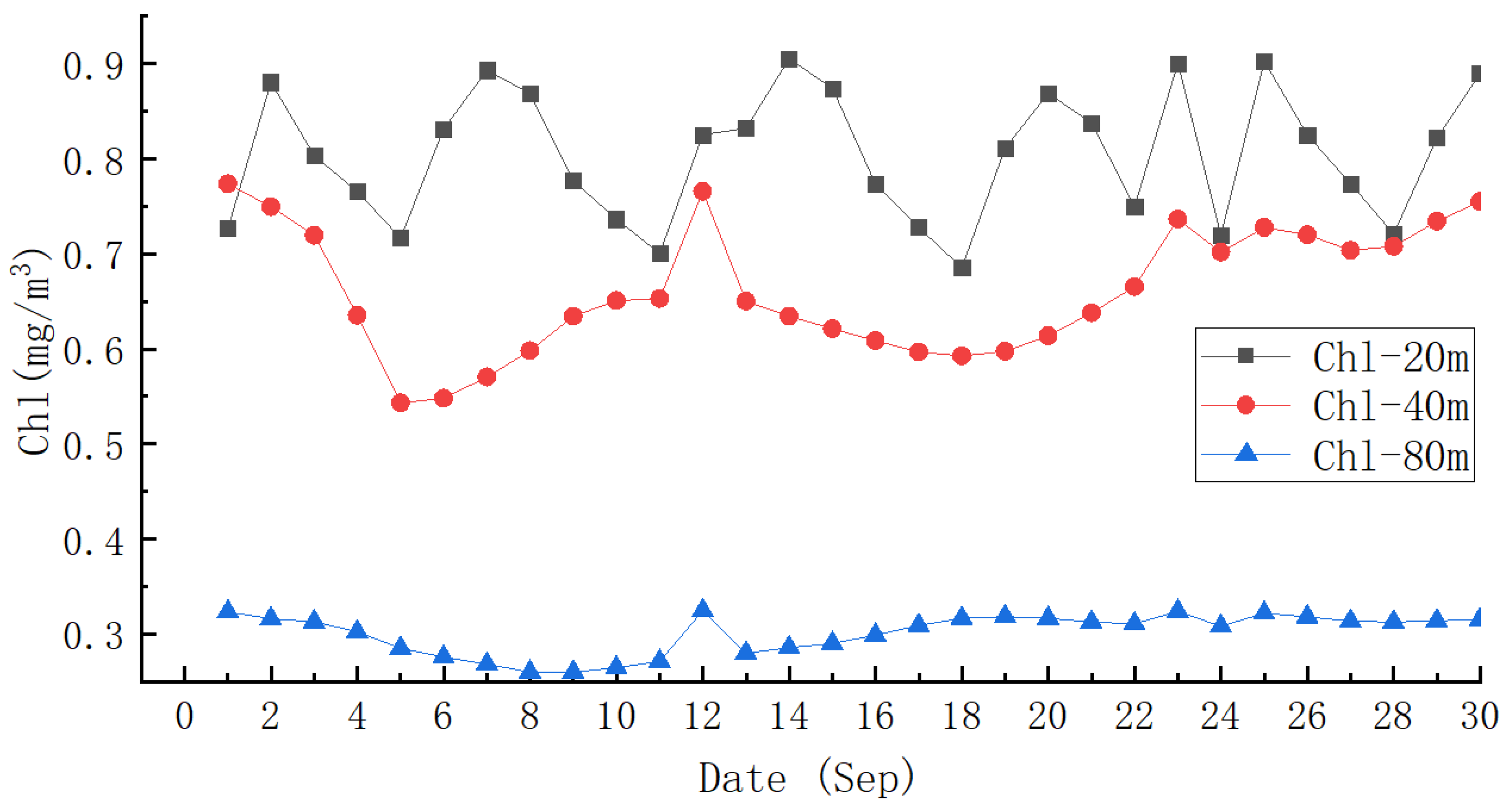
Disclaimer/Publisher’s Note: The statements, opinions and data contained in all publications are solely those of the individual author(s) and contributor(s) and not of MDPI and/or the editor(s). MDPI and/or the editor(s) disclaim responsibility for any injury to people or property resulting from any ideas, methods, instructions or products referred to in the content. |
© 2023 by the authors. Licensee MDPI, Basel, Switzerland. This article is an open access article distributed under the terms and conditions of the Creative Commons Attribution (CC BY) license (https://creativecommons.org/licenses/by/4.0/).
Share and Cite
Wang, J.; Guo, B.; Ji, Z.; Che, Y.; Mantravadi, V.S. Effects of Typhoon Chanthu on Marine Chlorophyll a, Temperature and Salinity. Atmosphere 2023, 14, 1505. https://doi.org/10.3390/atmos14101505
Wang J, Guo B, Ji Z, Che Y, Mantravadi VS. Effects of Typhoon Chanthu on Marine Chlorophyll a, Temperature and Salinity. Atmosphere. 2023; 14(10):1505. https://doi.org/10.3390/atmos14101505
Chicago/Turabian StyleWang, Jushang, Biyun Guo, Zhaokang Ji, Yingliang Che, and Venkata Subrahmanyam Mantravadi. 2023. "Effects of Typhoon Chanthu on Marine Chlorophyll a, Temperature and Salinity" Atmosphere 14, no. 10: 1505. https://doi.org/10.3390/atmos14101505
APA StyleWang, J., Guo, B., Ji, Z., Che, Y., & Mantravadi, V. S. (2023). Effects of Typhoon Chanthu on Marine Chlorophyll a, Temperature and Salinity. Atmosphere, 14(10), 1505. https://doi.org/10.3390/atmos14101505






